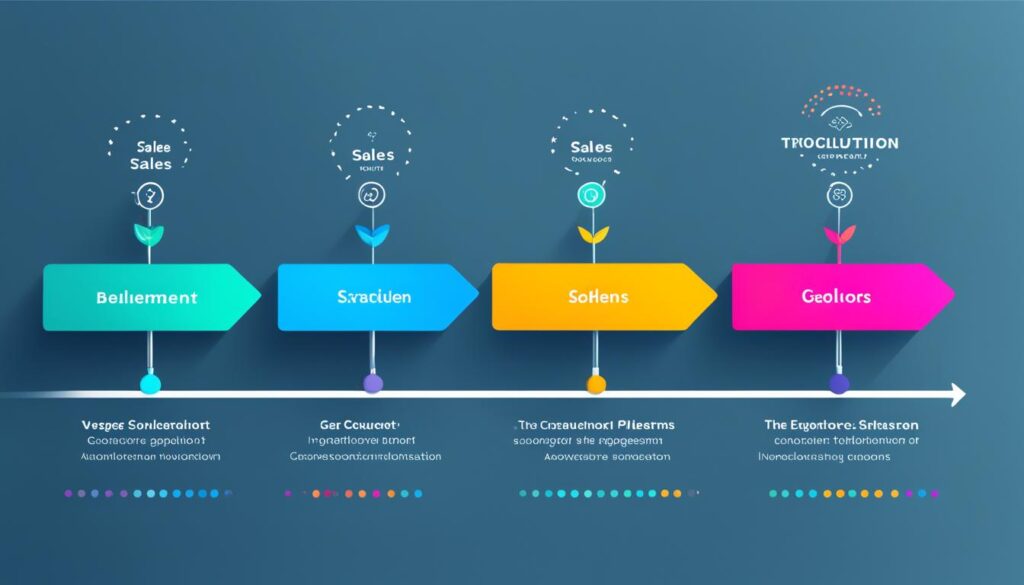Are you looking for ways to boost the performance of your sales team? Look no further than sales enablement tools. Sales enablement is a strategic discipline that equips sales teams with the tools, resources, and training they need to effectively engage prospects and close deals.
By empowering your sales team with cutting-edge sales enablement tools, you can unlock growth opportunities and take your sales performance to new heights. These tools provide valuable insights, automate manual tasks, and streamline the sales process, allowing your team to focus on what they do best – selling.
From CRM systems and content management platforms to sales training software and analytics tools, sales enablement tools are designed to optimize every stage of the sales cycle. They enable your team to deliver personalized experiences, enhance collaboration, and close deals faster.
Investing in sales enablement tools is an investment in your sales team’s success. It not only equips them with the resources they need to excel but also empowers them to reach their full potential and achieve remarkable results.
Join the ranks of successful companies that have harnessed the power of sales enablement tools to drive growth and outperform the competition. Start today and unlock the full potential of your sales team.
The Difference Between Sales Enablement & Revenue Enablement
In the realm of business growth and revenue generation, two key concepts emerge: sales enablement and revenue enablement. While both focus on driving success and growth, they encompass different scopes and approaches. To fully understand the distinction, let’s delve into the unique characteristics of each.
Sales Enablement: Equipping Sales Teams for Success
Sales enablement, as the name suggests, revolves around empowering sales teams with the necessary tools, resources, and training to boost their performance. It encompasses a range of activities such as providing access to sales collateral, implementing effective sales methodologies, delivering targeted training programs, and leveraging technology to streamline processes.
“Sales enablement is all about equipping your sales team with the knowledge, skills, and resources they need to engage prospects, overcome objections, and close more deals.”
This strategic discipline focuses primarily on enhancing the capabilities and effectiveness of the sales force. By arming them with the right resources and training, sales enablement helps sales teams navigate the complexities of the buying journey, address customer pain points, and ultimately drive revenue.
Revenue Enablement: A Holistic Approach for Sustained Success
While sales enablement focuses on the sales function specifically, revenue enablement takes a broader approach. It encompasses all revenue-generating functions within an organization, including sales, marketing, customer success, and more. Revenue enablement is a strategic and integrated initiative that aligns these functions, working cohesively towards achieving sustained success and unlocking new levels of growth.
“Revenue enablement takes a holistic approach, recognizing that sustained success requires alignment and collaboration across all revenue-focused areas of an organization.”
By aligning sales, marketing, customer success, and other revenue-focused teams, revenue enablement ensures that every touchpoint in the customer journey is optimized. This integrated approach allows businesses to create a seamless experience, increase customer satisfaction, and drive long-term revenue growth.

The Evolution of Enablement
Sales enablement has long been recognized as a crucial function in equipping sales teams with the tools, training, and resources they need to succeed. However, it is often misunderstood as a singular focus on sales enablement practitioners. This is only a glimpse of the broader picture.
There has been a shift towards a more holistic approach with revenue enablement. While sales enablement primarily focuses on equipping sales teams, revenue enablement recognizes the importance of aligning all revenue-focused functions within an organization to drive sustained growth and success.
This evolution of enablement acknowledges that sales teams alone cannot achieve optimal results without the support and collaboration of other critical revenue-generating functions, such as marketing, customer success, and operations.
Revenue enablement represents a paradigm shift, empowering organizations to leverage the collective expertise and resources of all teams involved in driving revenue growth.
By embracing this broader perspective, companies can optimize their sales performance, align marketing efforts with sales goals, and enhance customer experiences throughout the entire customer journey.
| Traditional Sales Enablement | Evolved Revenue Enablement |
|---|---|
| Focuses on sales teams | Aligns all revenue-focused functions |
| Equips sales teams with tools and resources | Optimizes the entire customer journey |
| Emphasizes individual performance | Drives collaboration and synergy across teams |
| Enhances sales productivity | Maximizes revenue outcomes |
By adopting a revenue enablement approach, companies can foster better communication, collaboration, and alignment among revenue-focused teams. This synergy enables organizations to unlock their full growth potential and achieve long-term business success.

Brands that embrace revenue enablement discover the power of aligning sales, marketing, customer success, and other revenue-focused functions. Together, these teams can drive meaningful results, satisfy customer needs, and position themselves as industry leaders.
The evolution of enablement represents a fundamental shift in how organizations approach revenue growth. It emphasizes the importance of integrating and aligning all revenue-focused functions, enabling businesses to thrive in an increasingly competitive landscape.
What EXACTLY is Revenue Enablement?
Revenue enablement goes beyond sales enablement and encompasses all revenue-generating functions. It focuses on aligning sales, marketing, operations, customer success, and other teams towards the common goal of driving sustainable revenue growth. Revenue enablement integrates strategies, processes, and technologies to optimize the entire customer lifecycle and maximize revenue outcomes.

By aligning sales and marketing efforts, revenue enablement enables organizations to effectively target and engage potential customers throughout the customer journey. This alignment ensures that marketing initiatives generate high-quality leads, and the sales team can efficiently convert those leads into customers. By optimizing the customer lifecycle, revenue enablement helps organizations deliver personalized experiences, build strong customer relationships, and drive revenue growth.
Through revenue enablement, organizations can leverage data-driven insights to identify customer pain points, preferences, and buying behaviors. By understanding the unique challenges and motivations of their customers, companies can develop tailored solutions and targeted messaging that resonate with their target audience. This customer-centric approach enhances customer satisfaction and increases the likelihood of repeat business and customer advocacy.
“Revenue enablement integrates strategies, processes, and technologies to optimize the entire customer lifecycle and maximize revenue outcomes.”
| Benefits of Revenue Enablement | Key Components |
|---|---|
|
|
Through revenue enablement, organizations can drive revenue growth, enhance customer satisfaction, and achieve long-term success. By aligning sales, marketing, and other revenue-focused functions, businesses can create a unified and customer-centric approach that maximizes the value delivered to customers and the value generated for the organization.
The 5 Values of Transitioning
The transition to revenue enablement brings five driving factors:
- Enhancing collaboration: Breaking down silos and fostering collaboration across revenue-focused teams.
- Improving customer insights: Collecting and analyzing customer data to gain deeper insights and deliver personalized experiences.
- Aligning sales and marketing: Working towards a common objective and optimizing lead generation and conversion rates.
- Empowered customer success: Extending focus beyond the sales cycle and driving customer success and expansion.
- Data-driven decision making: Embracing data analytics and insights to inform decision making and optimize revenue outcomes.
| Value | Description |
|---|---|
| Enhancing collaboration | Breaking down silos and fostering collaboration across revenue-focused teams. |
| Improving customer insights | Collecting and analyzing customer data to gain deeper insights and deliver personalized experiences. |
| Aligning sales and marketing | Working towards a common objective and optimizing lead generation and conversion rates. |
| Empowered customer success | Extending focus beyond the sales cycle and driving customer success and expansion. |
| Data-driven decision making | Embracing data analytics and insights to inform decision making and optimize revenue outcomes. |
COMMUNICATION. COLLABORATION. ORCHESTRATION
Effective communication, seamless collaboration, and efficient orchestration are essential elements of a successful revenue enablement strategy. By prioritizing these aspects, businesses can optimize sales performance, enhance customer experiences, and drive long-term success.
Communication plays a vital role in revenue enablement. It ensures that all members of the revenue-focused teams are aligned, informed, and working towards common goals. With open lines of communication, teams can collaborate effectively, share insights, and address challenges more efficiently.
“Effective communication is the cornerstone of any successful business. It enables teams to coordinate efforts, share knowledge, and align strategies, ultimately driving business growth.”
Collaboration is another key factor in revenue enablement. By fostering a culture of collaboration, businesses encourage cross-functional teamwork, innovation, and knowledge sharing. When sales, marketing, operations, and customer success teams collaborate closely, they can leverage their collective expertise to identify new opportunities, address customer needs holistically, and deliver exceptional value.
Orchestration is the art of aligning different revenue-focused functions and processes seamlessly. It involves optimizing the interactions between teams, technologies, data, and channels to create a unified and frictionless experience for customers. With effective orchestration, businesses can streamline operations, maximize efficiency, and optimize revenue outcomes.
Benefits of Communication, Collaboration, and Orchestration in Revenue Enablement
The strategic incorporation of communication, collaboration, and orchestration into revenue enablement can yield several benefits:
- Enhanced Sales Performance: Improved communication leads to better collaboration, enabling sales teams to leverage collective expertise and resources to drive results.
- Exceptional Customer Experiences: Effective collaboration and orchestration ensure that customers receive consistent, personalized experiences at every touchpoint.
- Increased Efficiency: Streamlined communication and collaboration processes minimize duplication of efforts, saving time and resources.
- Better Decision Making: Transparent and efficient communication facilitates data-driven decision-making, enabling teams to make informed choices based on actionable insights.
- Cross-Functional Alignment: Communication, collaboration, and orchestration align revenue-focused teams, breaking down silos and fostering a cohesive approach.
By prioritizing communication, collaboration, and orchestration as integral components of revenue enablement, businesses can foster a culture of synergy, drive sales performance, and achieve long-term success.
| Benefits of Communication, Collaboration, and Orchestration in Revenue Enablement |
|---|
| Enhanced Sales Performance |
| Exceptional Customer Experiences |
| Increased Efficiency |
| Better Decision Making |
| Cross-Functional Alignment |
Conclusion
Sales enablement and data enablement are two powerful tools that businesses can leverage to unlock business growth. By combining the strategic discipline of sales enablement with the insights and capabilities of data enablement, you can drive sales performance, enhance customer experiences, and achieve long-term success.
Implementing sales and data enablement requires operational rigor, collaboration, and a focus on metrics that matter. By investing in enablement and leveraging the synergy between sales and data, you can maximize your growth potential and stay ahead in today’s competitive landscape.
With sales enablement, you can empower your sales team with the tools, resources, and training they need to effectively engage prospects and close deals. Data enablement, on the other hand, provides you with valuable insights and analytics to inform your decision making and optimize your revenue outcomes.
By integrating sales enablement and data enablement into your business strategy, you can create a winning formula for success. Embrace the power of synergy, implement these enablement practices, and watch your business grow to new heights.
FAQ
What is sales enablement?
Sales enablement is a strategic discipline that equips sales teams with the tools, resources, and training they need to effectively engage prospects and close deals.
What is the difference between sales enablement and revenue enablement?
Sales enablement traditionally focused on equipping sales teams, while revenue enablement expands to encompass all revenue-generating functions within an organization.
How has sales enablement evolved over time?
Sales enablement has long been recognized as a crucial function, but it is often misunderstood. It has been traditionally tied to equipping sales teams with the tools, training, and resources they need.
What does revenue enablement involve?
Revenue enablement goes beyond sales enablement and encompasses all revenue-generating functions. It focuses on aligning sales, marketing, operations, customer success, and other teams towards the common goal of driving sustainable revenue growth.
What are the values of transitioning to revenue enablement?
The values of transitioning to revenue enablement include enhancing collaboration, improving customer insights, aligning sales and marketing, empowering customer success, and embracing data-driven decision making.
What is the importance of communication, collaboration, and orchestration in revenue enablement?
Communication, collaboration, and orchestration are crucial elements of revenue enablement. They help optimize sales performance, create exceptional customer experiences, and achieve long-term business success.
What is the synergy between sales enablement and data enablement?
Sales enablement and data enablement, when combined, can drive sales performance, enhance customer experiences, and achieve long-term success. Implementing both requires operational rigor, collaboration, and a focus on metrics that matter.
